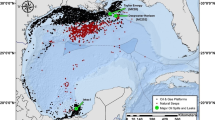Abstract
Approximately 8 years after the Exxon Valdez oil spill, river otters (Lutra canadensis) were trapped from the shoreline in both oiled (Knight Island) and nonoiled (Jackpot Bay) areas of Prince William Sound, Alaska. Captive river otters were wiped with isopropanol-soaked gauze and the gauze extracts were analyzed by gas chromatography with mass spectrometry detection. Differences in pentacosane (C-25) levels in the fur were observed between the oiled and nonoiled sites, while lower molecular weight aliphatics and aromatics were absent. These data are useful when evaluating the role of fur grooming in the long-term exposure of river otters to hydrocarbons and the expression of P450-1A in Knight Island otters.
Similar content being viewed by others
Author information
Authors and Affiliations
Additional information
Accepted: 26 August 1998
Rights and permissions
About this article
Cite this article
Duffy, L., Hecker, M., Blundell, G. et al. An analysis of the fur of river otters in Prince William Sound, Alaska: oil related hydrocarbons 8 years after the Exxon Valdez oil spill. Polar Biol 21, 56–58 (1999). https://doi.org/10.1007/s003000050332
Issue Date:
DOI: https://doi.org/10.1007/s003000050332




